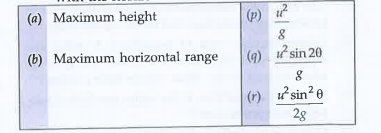The angle of which the velocity vector of a projectile thrown with a velocity u at an angle θ to the horizontal will take with the horizontal after time t of its being thrown up is
θ
tan−1(θt)
tan−1(vcosθvsinθ−gt)
tan−1(vsinθ−gtvcosθ)
The correct Answer is:d
To find the angle that the velocity vector of a projectile makes with the horizontal after a time t, we can follow these steps:
1. Identify Initial Velocity Components:
The initial velocity u is given at an angle θ to the horizontal. We can resolve this velocity into horizontal and vertical components:
- Horizontal component ux=ucosθ
- Vertical component uy=usinθ
2. Determine the Vertical Velocity After Time t:
The vertical velocity vy after time t can be calculated using the equation of motion:
vy=uy−gt
where g is the acceleration due to gravity. Substituting uy:
vy=usinθ−gt
3. Determine the Horizontal Velocity After Time t:
The horizontal velocity vx remains constant throughout the projectile's motion (since there is no horizontal acceleration):
vx=ux=ucosθ
4. Calculate the Angle with the Horizontal:
The angle ϕ that the velocity vector makes with the horizontal can be found using the tangent function:
tanϕ=vyvx
Substituting the values of vy and vx:
tanϕ=usinθ−gtucosθ
5. Find the Angle ϕ:
To find the angle ϕ, we take the arctangent:
ϕ=tan−1(usinθ−gtucosθ)
Final Answer:
The angle ϕ that the velocity vector makes with the horizontal after time t is:
ϕ=tan−1(usinθ−gtucosθ)
The initial velocity u is given at an angle θ to the horizontal. We can resolve this velocity into horizontal and vertical components:
- Horizontal component ux=ucosθ
- Vertical component uy=usinθ
The vertical velocity vy after time t can be calculated using the equation of motion:
vy=uy−gt
where g is the acceleration due to gravity. Substituting uy:
vy=usinθ−gt
The horizontal velocity vx remains constant throughout the projectile's motion (since there is no horizontal acceleration):
vx=ux=ucosθ
The angle ϕ that the velocity vector makes with the horizontal can be found using the tangent function:
tanϕ=vyvx
Substituting the values of vy and vx:
tanϕ=usinθ−gtucosθ
To find the angle ϕ, we take the arctangent:
ϕ=tan−1(usinθ−gtucosθ)
The angle ϕ that the velocity vector makes with the horizontal after time t is:
ϕ=tan−1(usinθ−gtucosθ)
Topper's Solved these Questions
- BOOK - A2ZCHAPTER - MOTION IN TWO DIMENSIONEXERCISE - Assertion Reasoning11videos
MOTION IN TWO DIMENSION
- BOOK - A2ZCHAPTER - MOTION IN TWO DIMENSIONEXERCISE - NEET Questions16videos
MOTION IN TWO DIMENSION
- BOOK - A2ZCHAPTER - MOTION IN TWO DIMENSIONEXERCISE - Kinematics Of Circular Motion26videos
MOTION IN TWO DIMENSION
- BOOK - A2ZCHAPTER - MOCK TESTEXERCISE - Motion With Constant Acceleration15videos
MOCK TEST
- BOOK - A2ZCHAPTER - NEWTONS LAWS OF MOTIONEXERCISE - Chapter Test30videos
NEWTONS LAWS OF MOTION
Similar Questions
Knowledge Check
- Question 1 - Select One
A stone is thrown with a velocity v at an angle θ with the horizontal.Its speed when it makes an angle β with the horizontal is
AvcosθBvcosβCvcosθcosβDvcosθcosβ - Question 2 - Select One
What is the range of a projectile thrown with velocity 98m/s with angle 30∘ from horizontal ?
A490√3mB245√3mC980√3mD100m - Question 3 - Select One
The time taken by a projectile thrown with a velocity v cm/sec at an angle α with the horizontal to attain the maximum height is given by
Av/gBv/sinαCvsinα/gD(vsinα)g
A projectile is fired with a velocity 'u' making an angle θ with the horizontal. Show that its trajectory is a parabola.
View SolutionA projectile is projected with velocity u making angle θ with horizontal direction, find : time of flight.
View SolutionA truck is moving horizontally with velocity v. A ball thrown vertically upward with a velocity u at angle θ to the horizontal from the truck relative to it. The horizontal range of the ball relative to the ground is
View SolutionA body is thrown with a velocity of 9.8m/s making an angle of 30∘ with the horizontal. It will hit the ground after a time
View SolutionWhen a body is thrown with a velocity u making an angle θ with the horizontal plane, the maximum distance covered by it in horizontal direction is
View Solution


